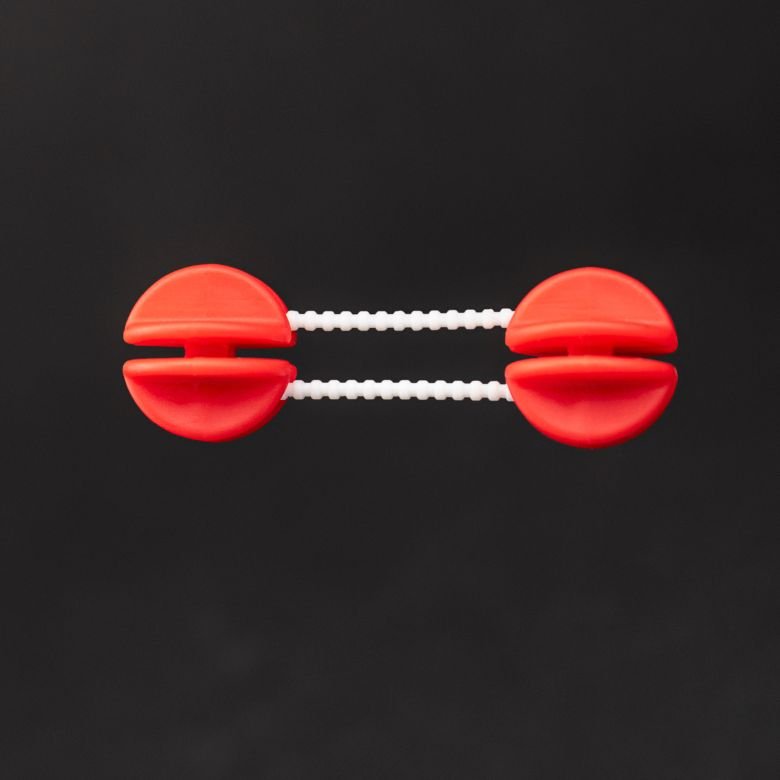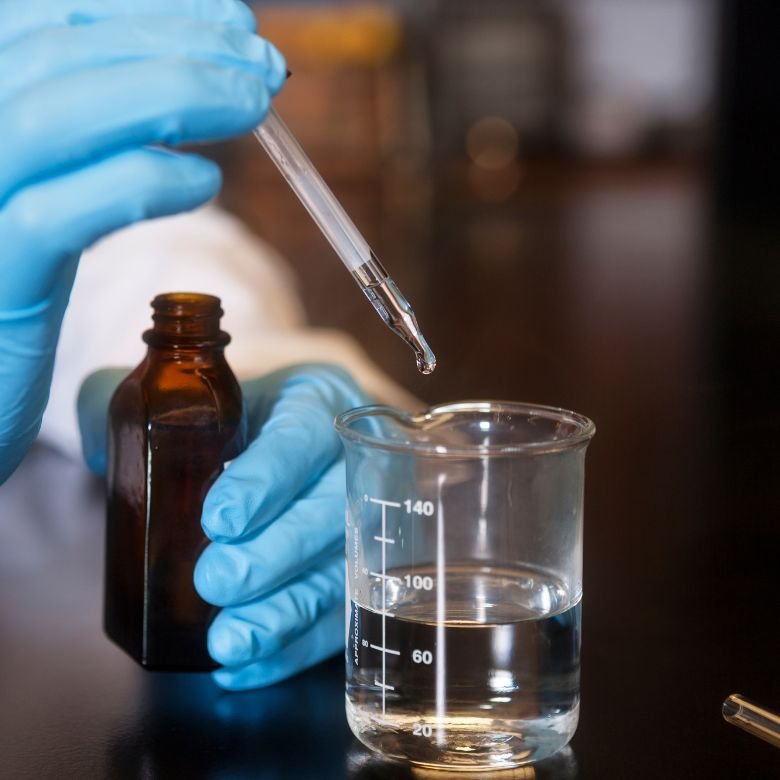The elements in group 16 of the periodic table are jointly referred to as chalcogens or the oxygen family. They include oxygen, sulphur, selenium, tellurium and polonium, and the group’s name comes from the first chemical element in the group. In this spectrum, we can observe a noticeable change in chemical properties along with the growing atomic mass. Oxygen and sulphur are typical elements with non-metal characteristics, selenium and tellurium are semi-metals characterised by transient characteristics, while polonium, positioned at the bottom of the group, has metallic properties. A characteristic feature of chalcogens is their capability of occurring in different molecular forms, in all three physical states. This is since they occur in various allotropic forms that differ in the number of atoms and the structure of space lattice.

Physical properties of chalcogens
The atomic mass grows along with the growing period of the element in the group. The lowest mass (16u) is characteristic of the oxygen (O) and the masses of 32u, 104u, 198u and 209u characterise the sulphur (S), selenium (Se), tellurium (Te) and polonium (Po), respectively. The atomic radius also increases with the growing period, which means that oxygen has the shortest radius of 73 pm. Another characteristic of chalcogens is their ionic radius that also grows with the increasing period. Its values for that group of elements begin with 140 pm for oxygen and end with 221 pm for tellurium.
However, as the number of period in the group increases, some features such as ionisation and electronegativity decline. The highest ionisation energy of 1314 [kJ·mol-1] characterises the oxygen atom, while for sulphur it is 999.6 [kJ·mol-1], 940.9 [kJ·mol-1] for selenium, 869.3 [kJ·mol-1] for tellurium, and 812 [kJ·mol-1] for polonium. The electronegativity values determined for each of the elements are the following:
- oxygen: 3.5,
- sulphur: 2.44,
- selenium: 2.48,
- tellurium: 2.01.
The melting and boiling points usually grow with the growing period.
| Element | Melting point [K] | Boiling point [K] |
| Oxygen | 54.36 | 90.18 |
| Sulphur | 388.36 | 717.80 |
| Selenium | 494.00 | 958.00 |
| Tellurium | 722.70 | 1261.00 |
| Polonium | 527.00 | 1235.00 |
Table 1. Melting and boiling points of chalcogens.
The electron configuration of chalcogens
The configuration of valence electrons characteristic of that group of elements is ns2p4. In addition, chalcogens show a tendency to accept two electrons, so, in practice, to take the configuration of the closest noble gas as their oxidation state switches to –II. Such transitions can be carried out in a few ways:
- If there is a large difference in electronegativity during the bonding of the elements, the chalcogen atom can accept two electrons and form an X2- Oxygen, being the most electronegative element in the group, forms ionic bonds with most metals, which leads to the production of such anions, O2-.
- It is possible to accept one electron and to produce one covalent bond. This is what happens in, for instance, hydroxides when a hydroxide ion OH– is formed, or in hydrogen sulphides with the hydrogen sulphide ion SH–. Such ions have various stability levels that decline from oxygen to selenium.
- The formation of two covalent bonds, for example in hydrides and halides. There are also bonds containing identical chalcogen atoms, such as in hydrogen peroxide or hydrogen disulphide. Oxygen has a tendency to bond into two or three atoms, while sulphur and selenium can form polyatomic chains as a result of catenation. Double bonds are most often formed by oxygen and sulphur, which is the case of urea or thiourea, for example. In addition, sulphur and further chalcogens (unlike oxygen, which is always in the –II oxidation state) can form more than two and even up to six covalent bonds. This is due to the presence of electrons also on the d orbitals of the valence shell, and their oxidation state can be IV or VI.

Allotropic varieties of oxygen
Oxygen occurs in two allotropic varieties: as the commonly found diatomic oxygen and as ozone with triatomic molecules. Diatomic oxygen molecules are paramagnetic and contain unpaired electrons at the anti-bonding π* orbitals. This is a triplet state, as its multiplicity is 3. Such an oxygen occurs in normal conditions as a colourless gas, slightly blue when forming thick layers and when in liquid or solid state. Its odour is noticeable, and it is slightly heavier than the air. In addition to the basic isotope, 16O, there are two more (17O and 18O) that can be found in small amounts in natural oxygen. As a result of some electric discharges, such O2 oxygen in the basic triplet state easily transforms into one of the two excited states. Both are rich in singlet state energy, but the lower one has one anti-bonding π* orbital with two oppositely spinned electrons. The higher excited state has one electron at each π* orbital with spins oriented anti-parallelly. The excitation occurs during the absorption of an appropriate quantum of light energy and as a result of transferring energy through the excited molecules of some dyes, for example chlorophyll and methylene blue. Such oxygen in the singlet state is a strong oxidant.
Allotropic varieties of sulphur
Depending on the conditions, elementary sulphur produces molecules with a ring or chained structure. There are many varieties of sulphur in solid and liquid states. At room temperature, a stable version is the rhombic sulphur (also called alpha sulphur) having a bright yellow colour. It is built of octoatomic molecules arranged to form a zigzag-shaped ring. When heated up to 368.8 K, it transforms into monoclinic sulphur. This variety is referred to as beta sulphur, which differs from its alpha equivalent by the arrangement of octoatomic S8 molecules. Monoclinic sulphur melts at 392.2 K to become a bright yellow, mobile liquid that is characterised at the molecular level by the equilibrium between acyclic sulphur and cyclooctasulphur. As the number of open chains increases in relation to to closed chains, the liquid’s freezing point declines. As the heating continues, the chains break off and undergo catenation, meaning that they bond with one another to form long chains. They can contain even up to 105 S8 units. Sulphur boils at 717.8 K, and the orange-and-yellow vapours being S8 molecules dissociate into molecules with a declining number of atoms. At 1200 K, gaseous sulphur mainly contains diatomic molecules. The slow condensation of sulphur vapours combined with cooling down to room temperature causes the formation of the so-called sulfatic acid, that is a dusty, bright yellow product. An abrupt cooling of the vapours down to the range of several to several dozen kelvins leads to the formation of products with various colours: violet, brown, green or yellow, depending on the cooling method.
Production of chalcogens
Oxygen
The raw materials required to produce oxygen on an industrial scale are air and water. The production of oxygen involves condensing the air and then separating the element of interest by factional distillation at around 0.3 MPa. The product so acquired normally contains approx. 3% of argon. The oxygen produced by water electrolysis stands out by very high purity. This is, however, a fairly expensive method used only in some countries. For laboratory purposes, small amounts of oxygen are usually produced by thermal breakdown of compounds such as potassium tetraoxomanganate (VII) or potassium trioxochlorate (V) in the presence of pure manganese (IV) oxide as catalyst.
Sulphur
The principal method of producing elementary sulphur is the refining of native sulphur. The Frasch process, mainly used in Texas and Louisiana, consists in displacing liquid sulphur melted with superheated steam under the effect of compressed air to the surface. This technology enables to acquire an extremely pure product that needs no refining. In Poland, that method is used near the town of Tarnobrzeg. In addition, sulphur is also a by-product of process technical gas treatment, for example when purifying natural gas of hydrogen sulphide and sulphur dioxide. Such extraction of hydrogen sulphide is carried out with methods such as the Claus process, that is a catalytic oxidation of hydrogen sulphide to produce sulphur and water.
Selenium
This element is a common contaminant present in sulphide ores and volcanic sulphur. During thermal processing of these materials, it transforms into selenium dioxide that occurs as a solid in the dusts collected by dedusting equipment. Thus, they constitute raw materials that can be the source of pure selenium. Such processing involves treating them with a potassium cyanide solution and then filtering off the produced solution and precipitating the Se under the effect of hydrochloric acid. Another method, more often applied in practice, is to acquire selenium from anode slimes that are formed by the electrolytic refining of copper.
Tellurium
The mentioned anode slimes also contain certain amounts of tellurium. Therefore, their processing is the principal method of producing it.

Applications of chalcogens
Oxygen has a wide range of applications. On an industrial scale, it is increasingly used in metallurgy and for steel refining in open-hearth furnaces. The process of welding metals in an acetylene-oxygen flame also consumes a lot of oxygen. In mining, active carbon saturated with liquid oxygen is used as an explosive. In medicine, oxygen is applied in the case of respiratory problems. Its alternative form, ozone, is used as a bactericidal for water disinfection.
Sulphur is one of the principal materials for producing sulphur dioxide that is then processed into sulphuric acid used as a disinfectant or whitener. In addition, sulphur is applied in such processes as rubber vulcanisation or the production of certain organic dyes, including carbon disulphide and ultramarine. It is also one of the raw materials required for producing black powder, fireworks or matches. Sulphur-based preparations are also applied in medicine (formulations that support treating skin diseases) and in agriculture (substances used for fighting plant parasites).
Selenium is required to produce photocells and rectifiers. It acts as a ruby-red dye in glass processing and is used in xerography.
Tellurium, as an additive to lead-based products, improves their mechanical strength and corrosion resistance. It is also a substrate used for making important semiconductor materials that are built of tellurides of heavy metals such as bismuth, antimony, lead, and cadmium.
Polonium is mostly applied as a testing source of alpha radiation and a source of heat in space equipment